

The Ultimate PWC Repellent
Advanced Tactical Weaponry for the catamaran sailor
  The Ultimate PWC Repellent Advanced Tactical Weaponry for the catamaran sailor |
|
In our quest for the best way to deal with PWCs, we decided that the best defense is a good offense. In our case, the best offense is close range advanced tactical weaponry. Although there is a multitude of weapons systems available, our extensive research and testing revealed that the AIM-9 Sidewinder heat seeking air-to-air missile was the best tool for the job. First fired in 1953, and designed primarily for fleet air defense, this missile was used extensively in the Southeast Asian conflict. The weapon has been improved steady over the years, with the AIM-9M being the latest model, which costs approximately $58,000 a pop. Earlier models such as the AIM-9L or AIM-9P may be available for your boat, but you are going to loose some features such as reduced smoke and enhanced resistance to both electronic and infrared countermeasures. 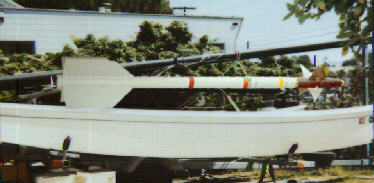
We mounted our AIM-9M on a 1981 Hobie 16, through the use of custom made mount points on the tramp siderails. The missile is approximately 9 1/2 feet long, so care should be taken to avoid mounting it too far aft, as it will inhibit rudder movement. The fins span over 2 feet, so it is highly recommended that the boat be trailered with the missiles off (although there are those will argue this). The missile weighs 190 lbs., and for light crews can be a significant improvement on the windward side in heavy air. Since the average PWC does not emit a thermal signature remotely close to that of a MIG-29, the heat seeking properties of the missile had to be "tweaked" to a high degree of sensitivity. This introduced some problems in our testing, as you will see. Test #1We tested our weapon at an undisclosed area along the Southern California coast. The area was heavily "infested" with PWCs, and was a perfect proving ground. |
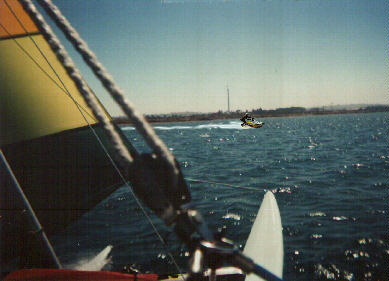 As soon as we set sail, a PWC immediately crossed our bow. 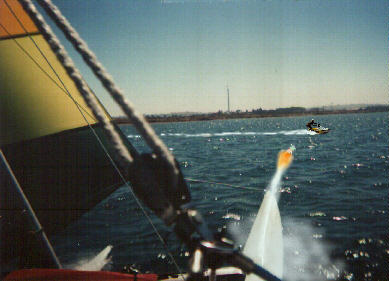 The targeting system immediately acquired the target and the missile was launched. The
tracking capability of the weapon was impressive.
The targeting system immediately acquired the target and the missile was launched. The
tracking capability of the weapon was impressive.
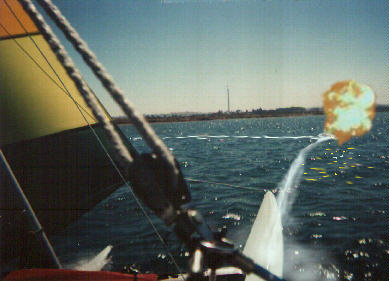 A confirmed kill.
A confirmed kill.
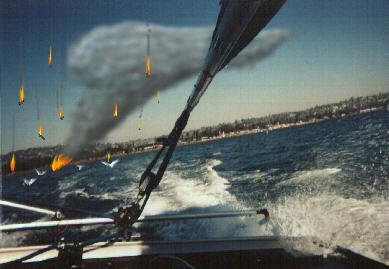 As we passed the explosion, we assessed the effectiveness of the weapon, which was
nothing short of amazing. The PWC had been reduced to some flaming wreckage at the
intercept site, which was surrounded by a 500 yard "debri field" being rained upon
by burning bits and pieces.
As we passed the explosion, we assessed the effectiveness of the weapon, which was
nothing short of amazing. The PWC had been reduced to some flaming wreckage at the
intercept site, which was surrounded by a 500 yard "debri field" being rained upon
by burning bits and pieces.
|
Test #2Our second test was performed with the objective of assessing the long range capabilities of the weapon. The "Crispy Critter", skippered by Frank "Nine Fingers" Pineau, was stationed in the targeting zone as an observer craft. |
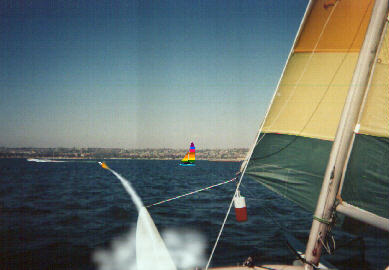 With a PWC sighted off of our port bow, and Frank to starboard, we acquired the PWC
and fired. For reasons not entirely known, Frank decides to light up a cigar.
With a PWC sighted off of our port bow, and Frank to starboard, we acquired the PWC
and fired. For reasons not entirely known, Frank decides to light up a cigar.
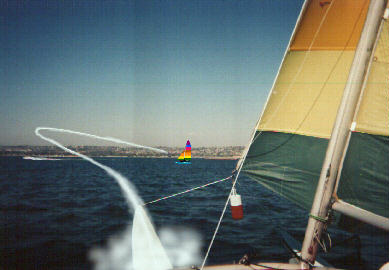 At this point it was apparent that the tweaking of the missile's heat seeking sensitivity was
to be our downfall. Frank starts shouting and waving his arms madly, the whole time
holding the lit cigar in his hand.
At this point it was apparent that the tweaking of the missile's heat seeking sensitivity was
to be our downfall. Frank starts shouting and waving his arms madly, the whole time
holding the lit cigar in his hand.
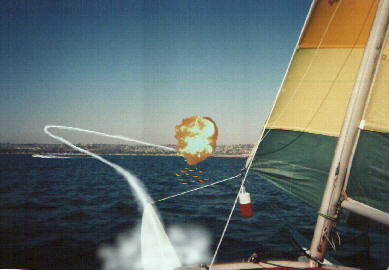 Sorry, Frank.
Sorry, Frank.
|
|
Other than the part where we blew up Frank's boat, our experience with the AIM-9M was overwhemlingly
positive. Frank was able to jump clear just before impact, and was quickly rescued. Due to the
extreme heat detection sensitivity required to target PWCs, considerable care should be excercised
regarding the environment in which these weapons are used. Nearby barbeques or cigar smoking sailors
can quickly interfer with targeting. Nothing ruins a nice shrimp barbeque quicker than an incoming
errant missile. In our case, we blew up a Hobie 16, scorched a perfectly good Hobie baseball cap,
and hopelessly "soiled" a really nice pair of burmuda shorts. It appears that when launching a Hobie in an area infested with PWCs, the most effective configuration is 2 of the missiles. The first is used early on, and the second is retained for the "deterrent effect". We noted that upon striking the first target, the remaing PWCs |
|
On The Wire would like to stress that this article is a parody and that all photos presented are ficticious. Please do not put a missile on your boat, blow something (or yourself) up, and blame us for giving you the idea. The whole things a joke. Really. Bill Mattson at mattson@earthlink.net |

|

|

|